在【Angular Change Detection:变化检测机制】这篇文章里介绍了 Angular 的变化检测机制,也提到了异步事件都会触发整个 Angular 应用的变化检测。
Angular 默认的变化检测机制是ChangeDetectionStrategy.Default:异步事件 callback 结束后,NgZone 会触发整个组件树至上而下做变化检测,如下所示:
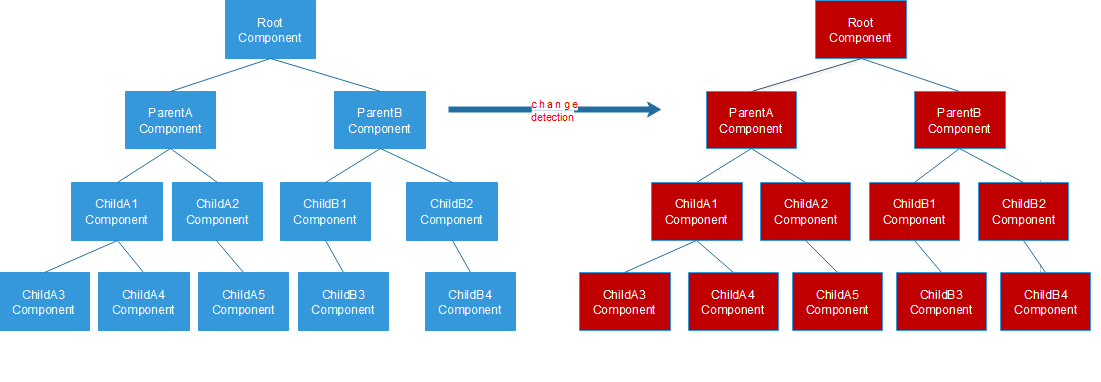
但是在实际应用里,并不是每个异步操作需要变化检测,某些组件也可以完全不用做变化检测,应用越大页面越复杂,过多的变化检测会影响整个应用的性能。Angular 除了默认的变化检测机制,也提供了ChangeDetectionStrategy.OnPush,用 OnPush 可以跳过某个组件或者某个父组件以及它下面所有子组件的变化检测,如下所示:

我们来看下 OnPush 具体是怎么用的:
定义一个 CDParentComponent 如下:
@Component({
template: `<h1>I am { { data.name } } and I live in { { data.address } } </h1>
<cd-child [data]="data"></cd-child>
<button (click)="changeInfo()">Change Info</button>`
})
export class CDParentComponent {
data: any = {
name: 'meii',
address: 'ShangHai',
contact: {
email: 'XXX@gmail.com',
phone: '1234567890'
}
};
changeInfo() {
this.data.contact.email = 'update@gmail.com';
this.data.contact.phone = '00000000';
this.data.name = 'limeii';
}
}
定义一个 CDChildComponent 如下:
@Component({
selector: "cd-child",
template: `<h3>here is email in the child: { { data.contact.email } } </h3>`,
changeDetection: ChangeDetectionStrategy.OnPush
})
export class CDChildComponent implements OnChanges {
@Input() data: any;
ngOnChanges() {
console.log('data has been changed: ' + this.data.name + ' ' + this.data.address);
}
}
在 CDChildComponent 加了一行代码:
changeDetection: ChangeDetectionStrategy.OnPush
我们点击 Change Info 按钮,不会触发 CDChildComponent 中的变化检测,页面 email 也不会有变化。
在 CDChildComponent 加了 OnPush 表示,在发生异步事件以后触发变化检测,Angular 会跳过这个组件,不会触发这个组件的变化检测。如果 OnPush 是加在某个父组件上,那么这个父组件和它下面所有的子组件都不会触发变化检测。
但是在实际应用里,我们并不希望把整个组件的变化检测都禁掉,而是希望部分操作还是可以触发它的变化检测,比如从后端 API 返回新的数据,虽然加了 OnPush,这些数据还是能够更新在页面上。
Angular 也涵盖了上述需求,在组件里加了 OnPush 策略,以下四种情况还是可以触发该组件的变化检测:
-
组件的
@Input引用发生变化。 -
组件的 DOM 事件,包括它子组件的 DOM 事件,比如 click、submit、mouse down。
-
Observable 订阅事件,同时设置 Async pipe。
-
利用以下方式手动触发变化检测:
- ChangeDetectorRef.detectChanges
- ChangeDetectorRef.markForCheck()
- ApplicationRef.tick()
1. 组件的 @Input 引用发生变化
必须是 @Input 的引用发生改变才会触发变化检测,并且仅限于 @Input 的变化检测,在 OnPush 策略下,会触发组件的变化检测。在这里先解释一下 JS 中的数据类型,在 JS 中有七种数据类型,其中包括六中原始类型(primitive values)和 Object。
六种原始类型分别为:Boolean、Null、Undefined、Number、String、Symbol (ECMAScript 6 新定义)。
除了 Object 以外的所有类型(即原始类型)都是不可变的(Immutable),是通过值传递的,每次对它们的改动都会在内存里生成一个新的值。而 Object 是通过引用传递的,每次对 Object 改动,引用不会改变。
在上面的示例代码CDParentComponent中的changeInfo方法如下:
changeInfo() {
this.data.contact.email = 'update@gmail.com';
this.data.contact.phone = '00000000';
this.data.name = 'limeii';
}
data 是一个对象,在changeInfo方法里通过如上方式改变 email 的值。同时在 CDChildComponent 设置了 OnPush,虽然@Input data的属性 eamil 发生变化但是 data 对象的引用并没有改变,并不会触发 CDChildComponent 中的变化检测,页面的 eamil 也不会发生变化。
如果把 CDParentComponent 中的changeInfo方法改成下面这样:
changeInfo() {
this.data = {
name: 'meii', address: 'ShangHai',
contact: {
email: 'update@gmail.com',
phone: '1234567890'
}
};
}
这时候点击 Change Info 按钮,触发了变化检测,页面的 email 被更新了:
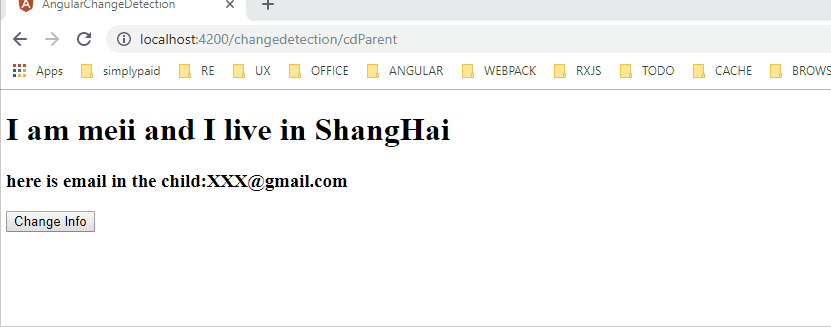
这种方式在改变 data 对象 email 值同时也改变了对象的引用。这时组件的 @Input 引用发生变化,虽然加了 OnPush 但 @Input 的变化检测还是会被触发。
2. 组件 DOM 事件触发
组件的 DOM 事件,包括它子组件的 DOM 事件,比如 click、submit、mouse down 等事件,在 OnPush 策略下,会触发组件的变化检测。
在 CDChildComponent 加一个 counter,并把它显示在页面里,在 ngOnInit 里把设置了 setInterval,每过一秒就让counter+1,代码如下:
@Component({
selector: "cd-child",
template: `<h3>here is email in the child: { {data.contact.email } }</h3>
<h3>here is counter in the child: { { counter } }</h3>
`,
changeDetection: ChangeDetectionStrategy.OnPush
})
export class CDChildComponent implements OnInit, OnChanges {
@Input() data: any;
counter: number = 1;
ngOnInit() {
setInterval(() => this.counter++, 1000);
}
ngOnChanges() {
console.log('data has been changed: ' + this.data.name + ' ' + this.data.address);
}
}
如果是默认的变化检测策略,setInterval 会触发组件变化检测,页面的 counter 会每过一秒就自动更新一次。现在 CDChildComponent 设置了 OnPush,setInterval 不会触发变化检测,页面上的 counter 不会有任何变化。
在 CDChildComponent 页面加一个按钮,在这个按钮的点击事件里,设置每点击一次按钮让counter+1,具体代码如下:
@Component({
selector: "cd-child",
template: `<h3>here is email in the child: { { data.contact.email } } </h3>
<h3>here is counter in the child: { { counter } } </h3>
<div style="margin-bottom:10px;">
<button (click)="changeCounter()">change child counter</button>
</div>`,
changeDetection: ChangeDetectionStrategy.OnPush
})
export class CDChildComponent implements OnChanges {
@Input() data: any;
counter: number = 1;
changeCounter() {
this.counter++;
}
ngOnChanges() {
console.log('data has been changed: ' + this.data.name + ' ' + this.data.address);
}
}
按钮点击事件是属于 DOM 事件,虽然在 CDChildComponent 设置了 OnPush,组件的 DOM 事件(或者它的子组件DOM事件)还是会触发这个组件的变化检测,页面的 counter 会更新
效果如下:
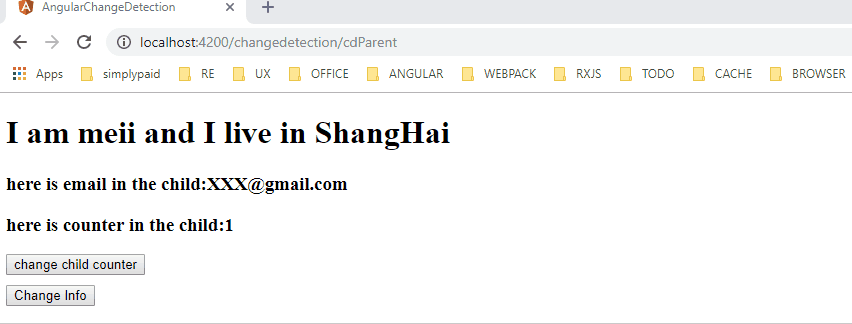
注意:这两个示例代码都是在@Input data引用没有发生变化的前提下运行的!
3. Observable 事件订阅,同时设置 Async pipe
在 CDChildComponent 有Observable事件订阅,并在模板里设置Async pipe,在 OnPush 策略下,会触发变化检测,代码如下:
@Component({
selector: "cd-child",
template: `<h3>here is email in the child: { { data.contact.email } } </h3>
<h3>here is counter in the child: { { count$ | async } } </h3>
<div style="margin-bottom:10px;">
<button (click)="changeCounter()">change child counter</button>
</div>`,
changeDetection: ChangeDetectionStrategy.OnPush
})
export class CDChildComponent implements OnInit, OnChanges {
@Input() data: any;
counter: number = 1;
count$: Observable<number>;
ngOnInit() {
this.count$ = interval(1000)
.pipe(
map((count: number) => ++count)
);
}
changeCounter() {
this.counter++;
}
ngOnChanges() {
console.log('data has been changed: ' + this.data.name + ' ' + this.data.address);
}
}
这时候页面的会每隔一秒更新一次:
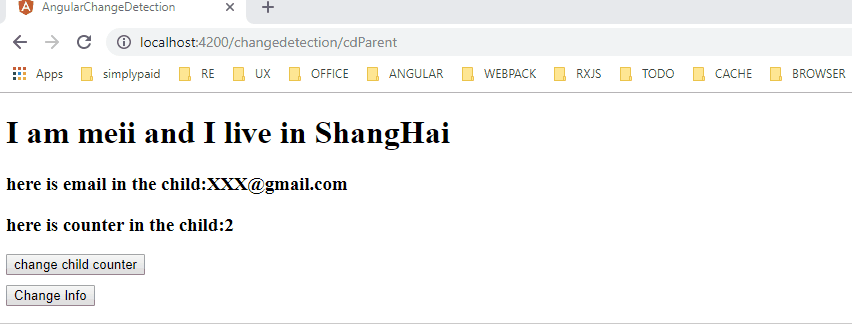
4. 手动触发
在 OnPush 策略下,手动调用这三种方式会触发变化检测:
- ChangeDetectorRef.detectChanges
- ChangeDetectorRef.markForCheck()
- ApplicationRef.tick()
4.1 ChangeDetectorRef.detectChanges()
代码如下:
@Component({
selector: "cd-child",
template: `<h3>here is email in the child: { { data.contact.email } } </h3>
<h3>here is the counter triggered manually in the child: { { counter } } </h3>
<div style="margin-bottom:10px;">
<button (click)="changeCounter()">change child counter</button>
</div>`,
changeDetection: ChangeDetectionStrategy.OnPush
})
export class CDChildComponent implements OnInit, OnChanges {
@Input() data: any;
counter: number = 1;
count$: Observable<number>;
constructor(private cd: ChangeDetectorRef) { }
ngOnInit() {
setInterval(() => {
this.counter = this.counter + 5;
this.cd.detectChanges();
}, 1000);
}
ngOnChanges() {
console.log('data has been changed: ' + this.data.name + ' ' + this.data.address);
}
}
每隔一秒,counter 自动加五,在 OnPush 策略下,组件会触发策略检测,页面每隔一秒会自动更新:
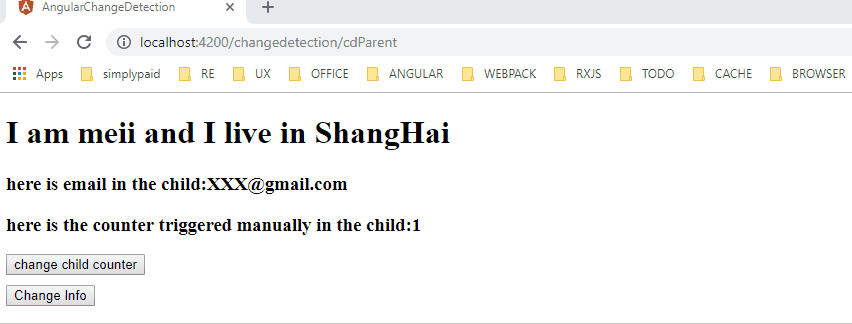
4.2:ChangeDetectorRef.markForCheck()
代码如下:
@Component({
selector: "cd-child",
template: `<h3>here is email in the child: { { data.contact.email } } </h3>
<h3>here is the counter triggered manually in the child: { { counter } } </h3>
<div style="margin-bottom:10px;">
<button (click)="changeCounter()">change child counter</button>
</div>`,
changeDetection: ChangeDetectionStrategy.OnPush
})
export class CDChildComponent implements OnInit, OnChanges {
@Input() data: any;
counter: number = 1;
count$: Observable<number>;
constructor(private cd: ChangeDetectorRef) { }
ngOnInit() {
setInterval(() => {
this.counter = this.counter + 10;
this.cd.markForCheck();
}, 1000);
}
ngOnChanges() {
console.log('data has been changed: ' + this.data.name + ' ' + this.data.address);
}
}
效果跟 detectChanges 是一样的,只不过 detectChanges 会立马触发当前组件和它子组件变化检测。markForCheck 并不会立马触发变化检测,而是标记需要被变化检测,在当前或下一轮的变化检测中被触发。
4.3:ApplicationRef.tick()
代码如下:
@Component({
selector: "cd-child",
template: `<h3>here is email in the child: { { data.contact.email } } </h3>
<h3>here is the counter triggered manually in the child: { { counter } } </h3>
<div style="margin-bottom:10px;">
<button (click)="changeCounter()">change child counter</button>
</div>`,
changeDetection: ChangeDetectionStrategy.OnPush
})
export class CDChildComponent implements OnInit, OnChanges {
@Input() data: any;
counter: number = 1;
count$: Observable<number>;
constructor(private applicationRef: ApplicationRef)) { }
ngOnInit() {
setInterval(() => {
this.counter = this.counter + 20;
this.applicationRef.tick();
}, 1000);
}
ngOnChanges() {
console.log('data has been changed: ' + this.data.name + ' ' + this.data.address);
}
}
ApplicationRef.tick() 触发整个应用的组件树从上到下执行变化检测。
总结
在实际应用开发过程中,应该尽量遵循以下的原则:
-
尽量使用 OnPush 策略从叶节点组件开始来优化整个应用的性能
-
尽量多结合使用 OnPush 和 async pipe
-
尽量多使用 state management library,比如 RxJS
本文中用到到的示例代码在这里:angular-change-detection